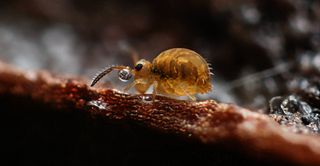
The orthopteran family Rhaphidophoridae of the suborder Ensifera has a worldwide distribution. Common names for these insects include cave crickets, camel crickets, spider crickets, and sand treaders. Those occurring in New Zealand are typically referred to as jumping or cave wētā. Most are found in forest environments or within caves, animal burrows, cellars, under stones, or in wood or similar environments. All species are flightless and nocturnal, usually with long antennae and legs. More than 500 species of Rhaphidophoridae are described.

George Vernon Hudson FRSNZ was a British-born New Zealand entomologist credited with proposing the modern daylight saving time. He was awarded the Hector Memorial Medal in 1923.

Trombicula, known as chiggers, red bugs, scrub-itch mites, or berry bugs, are small arachnids in the Trombiculidae family. In their larval stage, they attach to various animals and humans, then feed on skin, often causing itching and trombiculosis. These relatives of ticks are nearly microscopic, measuring 0.4 mm (0.01 in), and have a chrome-orange hue. A common species of harvest mite in North America is Trombicula alfreddugesi.

Campbellana is a genus of moths of the Carposinidae family, containing only one species, Campbellana attenuata. This species is endemic to the Campbell Islands of New Zealand.
Jacqueline Nancy Mary Adams was a New Zealand botanical illustrator, botanical collector, phycologist and museum curator. Throughout her career (1943–1987), she worked at DSIR and later at the Dominion Museum in different roles as technician, artist and assistant curator of botany. Largely self-taught, Adams collected over 3300 botanical specimens in New Zealand, illustrated nearly forty publications on algae and other native plants, and authored numerous scientific publications. Her major work, Seaweeds of New Zealand – An Illustrated Guide, was published in 1994.

Katiannidae is a family of Collembola. Genera of the family include Sminthurinus and Vesicephalus.

Cryptopygus is a genus of springtails. Cryptopygus belongs to the Isotomidae family.

Proterodesma turbotti is a species of moth in the family Tineidae. It was described by John Salmon & John David Bradley in 1956. This species is endemic to New Zealand, found in the Antipodes Islands and Bounty Islands of the New Zealand Subantarctic Islands.

Dicyrtomina is a genus of globular springtails in the family Dicyrtomidae..
Herbert Womersley (1889–1962) was an entomologist whose works were especially concerned with mites and ticks, silverfish and flies. His research into the diversity of Australian resulted in descriptions of new insect taxa.
Guntheria is a genus of mites in the family Trombiculidae. The species of this genus are found in Australia and the islands to its north.
John Tenison Salmon was a New Zealand photographer, entomologist, academic, conservationist, and author. His primary occupation was as an entomologist; first at the Dominion Museum and then at Victoria University College.

Keith Arthur John Wise, often referred to as K. A. J. Wise, was a New Zealand entomologist. Originally employed at the Department of Scientific and Industrial Research, Wise began working with the Bishop Museum in the early 1960s, coordinating field programmes for United States visits to Antarctica and Subantarctic islands. This work led Wise to identify and describe large numbers of novel species, including many species of springtail. In 1965, Wise became the first Curator of Entomology at the Auckland War Memorial Museum, where he was integral in creating the first entomology section within the natural history gallery.

Acanthomurus is a genus of Collembola belonging to the family Isotomidae. The genus was first described by Herbert Womersley in 1934, and is found in Tasmania, New Zealand and the Subantarctic islands.

Acanthomurus rivalis is a species of springtail belonging to the family Isotomidae. The species was first described by Keith Arthur John Wise in 1964. The species is native to Campbell Island in the New Zealand Subantarctic Islands.

Cryptopygus campbellensis is a species of springtail belonging to the family Isotomidae. The species was first described by Keith Arthur John Wise in 1964. The species is native to Campbell Island in the New Zealand Subantarctic Islands.

Friesea litoralis is a species of springtail belonging to the family Neanuridae. The species was first described by Keith Arthur John Wise in 1964. The species is native to Campbell Island in the New Zealand Subantarctic Islands.

Parakatianna salmoni is a species of springtail belonging to the family Katiannidae. The species was first described by Keith Arthur John Wise in 1964. The species is native to Campbell Island in the New Zealand Subantarctic Islands.
Pseudosorensia atlantica is a species of springtail belonging to the family Isotomidae. The species was first described by Keith Arthur John Wise in 1970, and is found in South Georgia.
Zelandanura is a monotypic genus of springtail belonging to the family Neanuridae. The sole species found in this genus is Zelandanura bituberculata. Both the genus and species were first described by Louis Deharveng and Keith Arthur John Wise in 1987. Zelandanura is endemic to Campbell Island in the New Zealand Subantarctic Islands.













